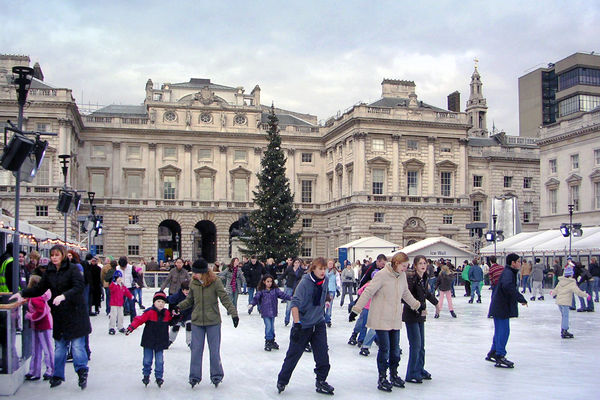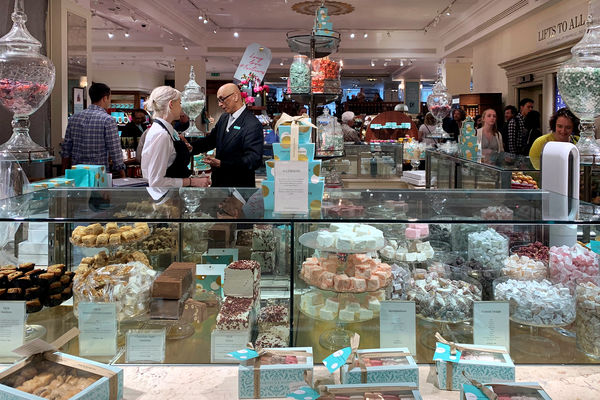Celebrating a Happy Christmas in England
Visit England at Yuletide to enjoy cozy markets, see Father Christmas in a grotto, and taste mince pies and "plum pudding."
By Rick Steves

A Christmas visit to England offers an unforgettable experience. Sure, the weather is reliably gloomy — but in the biggest cities, impressive light displays illuminate streets busy with shoppers, and German-style market stalls fill town squares around the country. Much like in the US, shops are dressed in their holiday best, skaters glide on outdoor ice rinks, busy bakers prepare traditional treats, carolers warm up with mugs of mulled wine, Scrooge sees the light on countless community stages, and Santa always seems to have time for kids eagerly counting the days until December 25.
It only makes sense that England's celebrations resemble ours in so many ways — it's where most of our shared holiday traditions began. (The big exception is Santa Claus, whose modern-day traits took shape in America and were gradually absorbed by England's Father Christmas. The two characters are now essentially the same jolly guy, but in British department stores he awaits eager children not in in his workshop but a "grotto" — usually less of a cavern than an old-fashioned sitting room.)
Most of the timeless-feeling holiday customs we share date back only a few generations to 19th-century England. Take Christmas trees: In England, homes and churches had been decorated with Yultide greenery for centuries, but hardly anyone there would have cut down or decorated a whole tree until Queen Victoria's German husband, Prince Albert, popularized the Germanic Tannenbaum in the 1840s. Charles Dickens' A Christmas Carol, first published in the same decade, helped cement this and other holiday customs, and with them the Victorian-era idea of the season as a time for generosity, open-heartedness, and childhood delight.
When he wrote it, the English had only recently reintroduced caroling itself — or rather reinvented it as a genteel celebration of convivial cheer. Special songs for Christmas are as old as the holiday itself, and the distinctive chords that make a carol sound "Christmassy" are rooted in medieval music. The custom of musical revelers roving from door to door also dates back to the Middle Ages, when "wassailing" was a way for English peasants to finagle food and charitable gifts out of the wealthy in exchange for entertainment. Wassailing became more aggressive over time, and many people — in America as well as England — came to consider it an excuse for extortion. Townsfolk who felt menaced by demanding ne'er-do-wells attempted to kill it off, with limited success. Eventually the Victorians incorporated wassailing into their revival of medieval choral music as festive songs, thereby inventing "caroling" as we now know it on both sides of the Atlantic.
But many other English Yuletide traditions either never made it across the pond or died off here long ago. Americans who visit England in December are treated to a mix of familiar delights and peculiar-seeming surprises.
Pantomime performances, affectionately called "pantos," are a uniquely British experience that have nothing to do with silent mimes (the name stems from their roots in ancient Rome) — or even with Christmas per se, though Advent is the traditional time to see them. These campy fairy-tale plays entertain with outrageous costumes, sets, and dance numbers. The audience is encouraged to chime in, and it doesn't take long to learn the lines ("It's behind you!"). Adults laugh at the risqué double entendres while kids giggle at the slapstick.
Feasting is just as big a part of the holidays in England as it is in the US, but Britain's most beloved Christmas goodies aren't ones that show up on many American tables.
"Mince pie" (what we call "mincemeat pie") has been a key part of English celebrations since the 16th century. The name refers to the original main ingredient of minced meat, which was mixed with chopped egg and ginger. Over time the recipe was fancied up with dried fruit and other sweets, and by the 19th century, the meat was all but gone, with the filling closely resembling today's mix of suet, spices, and dried fruit steeped in brandy. Superstition dictates that bakers stir the filling clockwise to ensure good luck in the coming year.
Britain's other big-name traditional Christmas treat — plum pudding — also has a misleading name, as it contains zero plums. And since Brits use "pudding" as a generic term for "dessert," Americans are often surprised to find that the dish is essentially a steamed cake. It shares key ingredients with mince pie: dried fruit (once called "plums"), suet, spices, and alcohol, plus breadcrumbs. It's akin to what we call "fruitcake" — but the English actually like it. Also called "Christmas pudding," it's essential as mince pie to any Brit's Christmas meal, and making it invovles even more ritual.
In Victorian times, on the last Sunday before Advent — renamed "Stir-up Sunday" in honor of the occasion — each family member would take a turn at mixing the thick batter while making a wish for the coming year (then resting their arms). Silver coins and/or good-luck trinkets, such as thimbles to ensure thrift, were tucked into the batter before it was boiled or steamed. The Victorians would then wrap their pudding in cloth and hang it up to marinate and form a "skin" over the coming weeks. On Christmas Day it was usually boiled again, then either topped with a sprig of holly or doused with brandy and lit on fire — and carried to the table with great fanfare. Though it's now common to buy a pre-made one from a shop, many English families still include some traditional elements in the making of their own "puds."
Before the Christmas meal comes a bit of goofy fun almost as important as the food: Christmas "crackers," another Victorian invention still going strong. At the table, each place setting includes a cracker — a colorful paper tube cinched at both ends like an oversized wrapped candy. If you find yourself presented with one, watch and learn: Once everyone's seated and ready, cross your arms, grab on tight to the tabs sticking out the ends of your neighbors' crackers, get ready to pull, and 3-2-1…crack! A paper crown, corny joke, and teeny gift spill out with the pop of actual gunpowder. Do as Queen Elizabeth was known to do and wear your paper crown all meal long. (I've also heard that she particularly enjoyed the dumb jokes.) But she got serious in time for the royal televised address to the nation at 3 p.m. — a tradition King Charles has continued — when the nation pauses to gather around the nearest telly and listen.
If you have the good fortune to be invited into an English home for the holidays, revel in the mix of familiar and strange sights, songs, and flavors. No matter how you experience an English Christmas, enrich your visit by asking the people you meet to describe their families' traditions. You may find yourself bringing some of them back home for next year.

